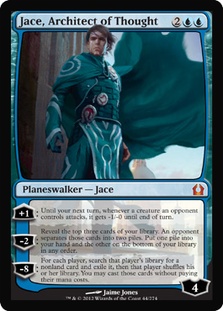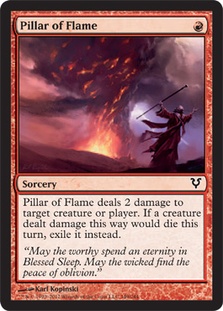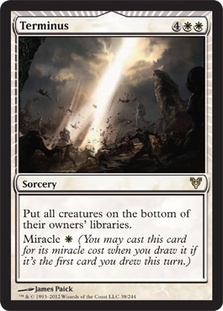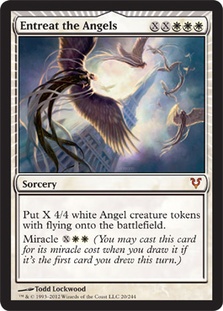Could you hear the collective sigh? Or was the blood pumping through your veins when you found out that a miracle control deck won the first Standard tournament with Return to Ravnica? Of course, I was all smiles, as I was the one receiving the trophy, but I can’t blame you if you hate the deck just because it has Glacial Fortress in it. But at least it isn’t a Delver deck!
But why hate a deck like this when it just breeds excitement? These are the cards that gather crowds, all waiting impatiently to see something miraculous. With each draw step, a chance. With each Loot of Desolate Lighthouse, a whisper. And with every Think Twice, crossed fingers. We can’t help but root for the blowout. It’s in our nature. We root for agony, and a lot of it. We can sense it in our fingertips. We can feel it in our bones. And we wait for it with bated breath. Waiting for what seems like forever. Waiting for the inevitable.
That, in essence, is a miracle.
I personally don’t like the mechanic. The cards themselves are sweet and would be much better (in my opinion) if they were less mana to cast normally and had some other ability. Miracles cause a lot of “unfun” games for opponents, but the games are so ridiculously fun to watch that it’s hard to complain or argue. If Terminus were just a reprint of Hallowed Burial, it wouldn’t get nearly as much press or see as much Legacy play. The same goes for Entreat the Angels versus Decree of Justice.
But I digress.
We are in an age where Magic needs press coverage. We need people to watch, and for those who are watching to actually enjoy themselves. Miracle cards can inspire crowds, sell boosters, and give the people what they want: the potential for anyone to be able to beat Brian Kibler. With all of this comes a little risk, since miracle is a mechanic that can get old after a while. There was a point where I saw at least one post on Facebook or Twitter every day where someone was complaining about Bonfire of the Damned, but I don’t think we’re even remotely close to that mass breaking point. We’re still infatuated with miracles and dream of the day we get to topdeck our miracle card for the win in a feature match on camera. Even though the stage was small, I have experienced this feeling a few times, and it feels great!
While the U/W/R Control deck Team SCG Blue played at the SCG Standard Open in Cincinnati was powerful, there are still some kinks to work out. This was the first tournament of the new format and was merely a glance at what the future holds. This time last year, I was piloting Illusions featuring Phantasmal Dragon with nary a Ponder or Vapor Snag in sight. That deck eventually evolved into the Delver deck you all love(d) and hate(d), but that just shows you how far we can go in just a short period of time.
When we fired up our playtesting videos over a month ago featuring Return to Ravnica spoilers, we learned a few things:
- Zombies is an awesome deck.
- Pillar of Flame is the best card to interact with Zombies in the early game.
- White-based aggro decks seem well positioned against Zombies.
- Control decks would have to be built to beat aggro decks without the other control decks in mind.
- No one has a good answer to Geist of Saint Traft since Phantasmal Image, Whipflare, and Slagstorm rotated.
Before we left Roanoke for the tournament last Friday, I needed to pick up some cards from the store. Return to Ravnica had just been released, and I needed to get some of the newer rares for my W/U Aggro deck featuring Geist of Saint Traft. I had played the deck (or something similar) in one of our playtesting sessions a few weeks ago, and the deck felt really powerful. Geist of Saint Traft is a card that needs to be built around because it’s just that good. While solid, the deck was still soft to Supreme Verdict and an onslaught of spot removal.
While the deck was good against Zombies, I hadn’t really tested it against much else. I felt like I might be an underdog against aggressive decks that were just going to get bigger than me and that I was relying a bit too much on Geist of Saint Traft. With it in play, a lot of the games felt really easy. Without it, the deck felt incredibly average, but I wasn’t really sure what else I could play. Gerry Thompson, Brad Nelson, and Brian Braun-Duin were all planning on playing a pretty solid-looking U/W/R Control deck, but I didn’t have any Jace, Architect of Thought, Entreat the Angels, Terminus, or Steam Vents. I thought they would be relatively difficult to find, so I just bought the $30 worth of White Weenie cards I needed (like Precinct Captain) and was ready to go!
After a relatively long journey, we arrived in Cincinnati pretty late in the evening but were all itching to battle. Brad sleeved up his deck, and we played some games. And by “played some games,” I mean that Brad smashed me six or seven games in a row. “Pillar of Flame this. Azorius Charm that. Snapcaster Mage on Pillar of Flame. Supreme Verdict your Geist. Terminus you. GG.”
…
Distraught. Dumbfounded. Defeated.
“Yeah… I’m just gonna play that deck.”
It was the only response I could muster when Gerry called me a big dummy for planning to play my W/U Aggro deck. I posted a notice on Twitter looking for the cards I needed, and a few awesome friends came through for me in the morning. Suffice it to say, it didn’t take much to get me to switch since I wasn’t feeling all that confident about the format in the first place, but their control deck was pretty awesome. Despite a Team Limited Grand Prix and Modern Pro Tour on the horizon, they found time to brew and test new cards. There is a reason they are two of the people I respect most in the Magic community. They live and breathe Magic, and I’m really glad some of that is starting to rub off on me. I even started carrying around a notebook to write down decklists (thanks GerryT!).
After getting cards for the deck at the last minute and playing virtually no games with it, I obviously went on to win the tournament. No big deal. Easy game. Fish in a barrel. Etc. No, seriously, to win with a miracle deck you need to actually draw the miracles on occasion. I got pretty lucky on more than one occasion in the tournament, and I think that may have been the big difference between the rest of the team and myself, as Brad and BBD both with 7-2 while I went 8-1 in the Swiss. For reference, here is the list we used in the tournament (barring a few changes by various team members):
Creatures (2)
Planeswalkers (6)
Lands (26)
Spells (26)

This is easily the second strongest deck I’ve ever played in a brand new format, behind Faeries at States a few years ago. We had it all! From card advantage to cheap removal to insane finishers, and we even got to play with the best new blue card in Standard:
While I was originally skeptical, I came around pretty quickly after playing just a few games against the new Jace. Unfortunately, I was usually playing some aggressive deck featuring a swarm of creatures, and Jace shut down my entire team! This wasn’t a card I was prepared to deal with at the time, but I don’t know if that will be much of an issue going forward.
You have to be able to beat this card if you want to succeed in Standard. If you play an aggressive deck, you need to have something like Detention Sphere, Dreadbore, Oblivion Ring, burn spells, or creatures that are threatening enough on their own so that you don’t have to overextend on the board and lose to a Supreme Verdict or Terminus.
In addition to all of this, you still have to remember that Jace can always draw cards. This is pretty absurd considering how powerful the first ability is. While the format is still in its infancy, I think that most aggressive decks will continue to lean on cheaper curves, which means swarms of smaller creatures. As people adapt to Jace, Architect of Thought, their curves will become a little bit higher since their threats need to hit harder. Unfortunately, this just helps you play right into their “Wrath away everything” plan.
I have no idea what the solution to this is…
I do know that I want to be the one casting Jace rather than the one fighting it off. Jace’s ability to protect himself exceeds any other planeswalker I’ve ever seen, though his ultimate can be rather lackluster at times. Going forward, I think that Jace will be one of the stronger cards to build your deck around regardless of what type of control deck you want to be. I don’t think that Jace really fits into an aggressive shell very well since you just want to attack your opponent all the time and Jace’s best ability is inherently defensive.
Next up, you’ll notice that the only red card we played in the entire deck was this little number:
Ah, yes. Another pillar of Standard. This one continues to impress and combos perfectly with Snapcaster Mage. Alongside Tamiyo, the Moon Sage, Pillar of Flame acts as an alternate win condition, allowing you to do your best 2x Fireball impression over and over again. Pillar of Flame is a strange card, but desperate times call for desperate measures. We’re in a world full of undying creatures, and we don’t have a lot of efficient options.
Alongside Azorius Charm and Detention Sphere, Pillar of Flame gives us just enough ways to annihilate our opponent’s early aggression. Afterwards, we use Jace or Tamiyo to draw some cards, stabilize, and eventually finish them off with an Entreat the Angels. This removal package worked very well, and I would definitely recommend keeping the red in the deck just for Pillar of Flame.
Ultimately, I know that people are going to try out different colors with this control shell, but a lack of efficient answers to cards like Gravecrawler, Geralf’s Messenger, and the rest of the undead crowd will leave your head feeling a bit empty. I’m saying they will eat your brain. Get it? That was a Zombie reference. If anything, I would try to add more cards to the deck to fend off the undead horde. Zombies was my only loss in the entire tournament, and Lotleth Troll felt like it was very hard to deal with.
The rest of the deck is full of some sweet cards, but the two cards you want to draw the most (at the right time, of course) are:
This is the bread and butter. This is the one-two punch. Without this combination, you’d be playing an entirely different deck. Every game you are just buying time until you bust out an Entreat the Angels on your draw step for 2+ Angels, all the while using Terminus (hopefully by miracle at some points) to wipe away all of their creatures. Of course, this means filling your deck with removal, which is probably bad against control. But so what? When almost every other archetype in the format revolves around creatures, removal can’t be a bad thing. Even the combo deck in the format, Reanimator, revolves around creatures and is very vulnerable to Terminus!
So at what point does it become bad to maindeck this many removal spells? For one, I think that Detention Sphere will be good for quite some time due to its flexibility, and the same goes for Azorius Charm. At the very least, it cycles. At most, it allows you to trigger Entreat the Angels on your opponent’s turn. Pillar of Flame may end up being an unnecessary element in the deck, but there were a lot of creatures that it killed in the Top 8 of the SCG Standard Open in Cincinnati, and I don’t foresee that changing much in the near future.
…
Cards to Cut
For starters, here are the cards I would cut entirely from the deck:


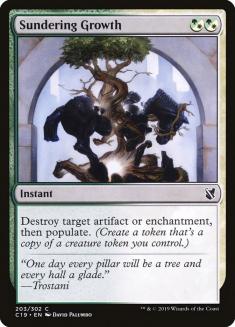

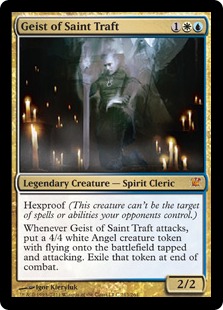


In theory, all of these cards were sound. We didn’t know how vulnerable we would be to Reanimator strategies, so we wanted a few hate cards in Purify the Grave, but I don’t think it’s necessary. You can stall them out pretty easily with Wrath effects and eventually kill them with a planeswalker or Entreat the Angels.
Sundering Growth should have just been Erase since it can permanently deal with Rancor. While Erase would be included mostly to answer Detention Sphere, it can come in handy against Zombies too! They will likely be bringing in Underworld Connections, which can actually grind you out on card advantage, and having an answer to the threats that are tough to deal with is pretty sweet. Combined with Snapcaster Mage, Erase is much easier to cast, and I don’t know of many artifacts that I’m really afraid of.
With Entreat the Angels in the deck, Geist of Saint Traft is going to catch some splash damage from Supreme Verdict. You just have to have Supreme Verdict in your deck after sideboard, and that means Geist is going to die over and over and probably isn’t worth the slots. I would recommend more counterspells, planeswalkers, and Erase effects if you want cards that are good in the mirror.
Every game I’ve played after the first in control mirrors so far has been a planeswalker battle, with Jace, Memory Adept usually being the trump card. Since Detention Sphere doesn’t kill him outright, you can use Erase to bring him back and continue the “beats.” Most games start out as draw go for a while as you both develop your mana, refusing to run your best threats into their counterspells. Whoever bites first usually loses, but that isn’t always the case. If you can protect your Jace or Tamiyo with a Negate, it’s usually right to go for it. After all, there really isn’t that much solid countermagic in the format.
Cards to Remember
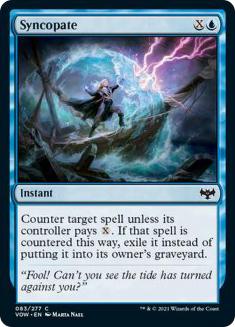

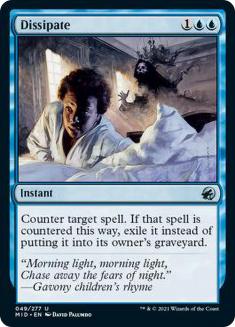



Syncopate was surprisingly awesome, and I would definitely recommend playing a few in the maindeck. Dissipate is a little slow, can be hard to cast on turn 3, and is really hard to flashback with Snapcaster Mage on turn 5. People will constantly run their spells into your Syncopates without thinking because everyone is under the impression that counterspells are dead thanks to the rotation of Mana Leak. That simply isn’t the case, and I think that Syncopate will end up seeing a lot of play in Standard since we really don’t have much else!
As for Dissipate and Negate, these are probably sideboard cards for control matchups, but I sided in Dissipate multiple times against slower aggressive/midrange decks. There are a lot of creatures like Thragtusk in the format that are tough to deal with, and you can’t really let them hit the table. Falkenrath Aristocrat is in the same boat but is annoying for another reason: it dodges most of your removal. The haste ability makes Azorius Charm much worse, and gaining indestructible makes Pillar of Flame pretty useless. Terminus is probably too slow, so we’re left with one answer: counterspells.
I feel like the lack of Cavern of Souls in aggressive decks will continue since there shouldn’t be much fear of counterspells. They really aren’t that good, but they’re basically all we have!
…
Other than that, I loved the deck and would recommend it to anyone looking for something new and fun to play! If control is your style and you love casting Think Twice, then this deck is definitely for you. You get to kill all the creatures, draw a bunch of cards, and finish them off in style! Without an aggro-control deck in the format to prey on this kind of control deck, I’m not really sure how people are going to “hate” you out. I think it will be difficult, but I’m sure people will adapt. Burn spells are quite good against the deck since we don’t have an efficient way to gain a lot of life. Azorius Charm (to gain life) only works well with Angels.
Maybe Wizards will just decide to help us out and reprint Kitchen Finks?
(Maybe that’s a little too much to ask.)
Thanks for reading!
strong sad on Magic Online
@strong_sad on Twitter (Follow me!)

